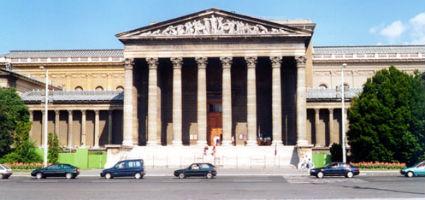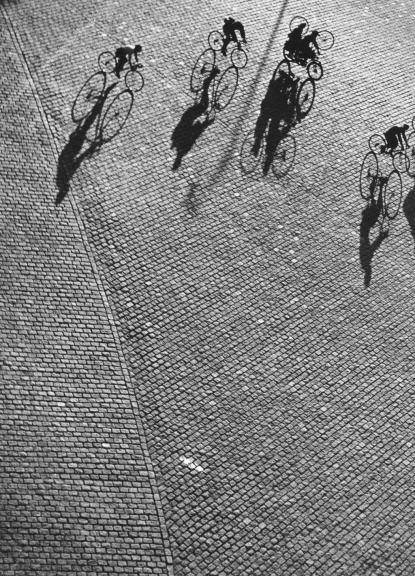2024. April 19. Friday
Budapest Museum of Fine Arts - Budapest
 |
Address: 1146, Budapest Dózsa György út 41.
Phone number: (1) 469-7100
E-mail: info@szepmuveszeti.hu
Opening hours: Tue-Sun 10:00-18:00
|
The exhibition has closed for visitors.
2010.10.27. - 2011.01.23.
Museum tickets, service costs:
|
Ticket for adults
(valid for the permanent exhibitions)
|
2800 HUF
|
/ capita
|
|
Ticket for adults
|
3200 HUF
|
|
|
Group ticket for adults
|
2900 HUF
|
|
|
Ticket for students
(valid for the permanent exhibitions)
|
1400 HUF
|
/ capita
|
|
Ticket for students
|
1600 HUF
|
|
|
Group ticket for students
|
1400 HUF
|
|
|
Ticket for pensioners
(valid for the permanent exhibitions)
|
1400 HUF
|
/ capita
|
|
Audio guide
|
800 HUF
|
|
|
Video
|
1000 HUF
|
An exhibition of selected works by Lucien Hervé will run from 27 October at the Budapest Museum of Fine Arts commemorating the 100th anniversary of the artist's birth. Some one hundred photographs recently added to the museum's collection as well as a large number of documents to be displayed for the public for the very first time will focus on the architectural photography of the Hungarian-born Lucien Hervé, while also providing a review of his entire oeuvre.

Lucien Hervé 100 will be the first exhibition in Hungary devoted entirely to the oeuvre of the photographer, who passed away three years ago. The show will presented Hervé's art not only through known and recognised photographic pieces but also through unknown works and even some that have not been displayed before. Thanks to scholarly research visitors can now also see documents that place the artist's activity, working method and network of relations into a wider context and through the numerous new findings will also attract the interest of those who are already well-versed in the photographer's work.
The artist was born under the name of László Elkán in Hódmezővásárhely, Hungary in 1910. He left Hungary at the age of 18 and after residing in Vienna for a year he travelled to Paris and settled there. Until 1939 he made his living working in a bank and then started writing articles and taking photographs for a magazine. During his time as a POW and in the French resistance during World War II a way opened up to him to pursue his artistic endeavours: to draw and paint. It was at this time that he adopted the alias of Hervé, which he used later as his artist name.
His career took a radical turn in 1949: he met Le Corbusier, who, seeing Hervé's photographs of his residential blocks being built in Marseille at the time, invited him to be his full-time photographer. From this point on Hervé systematically photographed all of Le Corbusier's outstanding architectural works, and he soon received invitations from other contemporary architects to record their work. The greater part of Hervé's oeuvre is composed of photographs taken of modern architecture. He also received commissions in the Near East, India and America and took several thousand photographs during his travels in France and Italy.
The individuality of Hervé's works is created by the stark, geometrical and daring cuts operating with the contrast between light and shadow, which, at the same time, are bereft of any kind of documentary approach. Le Corbusier said that these photographs helped him to better understand his own buildings.

Lucien Hervé 100 will be the first exhibition in Hungary devoted entirely to the oeuvre of the photographer, who passed away three years ago. The show will presented Hervé's art not only through known and recognised photographic pieces but also through unknown works and even some that have not been displayed before. Thanks to scholarly research visitors can now also see documents that place the artist's activity, working method and network of relations into a wider context and through the numerous new findings will also attract the interest of those who are already well-versed in the photographer's work.
The artist was born under the name of László Elkán in Hódmezővásárhely, Hungary in 1910. He left Hungary at the age of 18 and after residing in Vienna for a year he travelled to Paris and settled there. Until 1939 he made his living working in a bank and then started writing articles and taking photographs for a magazine. During his time as a POW and in the French resistance during World War II a way opened up to him to pursue his artistic endeavours: to draw and paint. It was at this time that he adopted the alias of Hervé, which he used later as his artist name.
His career took a radical turn in 1949: he met Le Corbusier, who, seeing Hervé's photographs of his residential blocks being built in Marseille at the time, invited him to be his full-time photographer. From this point on Hervé systematically photographed all of Le Corbusier's outstanding architectural works, and he soon received invitations from other contemporary architects to record their work. The greater part of Hervé's oeuvre is composed of photographs taken of modern architecture. He also received commissions in the Near East, India and America and took several thousand photographs during his travels in France and Italy.
The individuality of Hervé's works is created by the stark, geometrical and daring cuts operating with the contrast between light and shadow, which, at the same time, are bereft of any kind of documentary approach. Le Corbusier said that these photographs helped him to better understand his own buildings.
